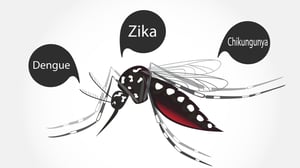Experiments against Aedes aegypti, responsible for transmitting diseases such as Zika and Dengue, are underway. The genes of male mosquitoes are altered to cause the death of female mosquitoes.
At the start of April, British company Oxitec released the genetically modified eggs of Aedes aegypti mosquitoes in six different areas of the Florida Keys.
These eggs only “hatch” male insects which have a gene designed to kill future females, the latter being the only type of mosquito that bites humans and transmits diseases such as Zika, Dengue, Chikungunya and, in some parts of the world, Yellow Fever.
How does it work?
When these males fertilise, females born in the wild, they transmit their modified gene which will only result in the death of female larvae. The males, on the other hand, survive, but in turn become carriers of the gene which kills future females.
As reported in Nature science magazine, around 12,000 males will leave the Oxitec containers each week over a 12-week period. Other eggs will also be released in a successive phase so that, by the end of the year, up to 20 million mosquitoes with a modified gene which is lethal for the females will have been released.
All of this will cause an imbalance which, according to the results of experiments already conducted in Brazil, Panama, Malaysia and the Cayman Islands, should drastically reduce the number of mosquitoes overall, and virtually rule out the possibility of a mosquito biting man, which only females are capable of doing.
A tortuous path
It is the outcome of a long and controversial ten-year journey which has ground to a halt on a number of occasions, because this type of operation is not contemplated by American law, and because part of the local population did everything in its power to prevent the mosquitoes from being released into the environment. The fear was it would have consequences for the ecosystem, and indeed for humans. The protesters also contested a lack of transparency in the information released by the authorities and by Oxitec (which in turn responded by accusing the anti-GMO groups of extreme disinformation). The experiment was monitored by the Florida Keys Mosquito Control District.
Who is right? It is a complex situation, and a many faceted one from the ethical and biological standpoint. The groups (including dozens of local doctors) which fought long and hard against the experiment, albeit to no avail, raised concerns about a technique which is still only experimental, and which has, in the past, yielded contrasting results. The most extremist of them actually threatened to spray insecticides near the release points to render the experiments void. As a result, Nature reports that Oxitec’s experts were ordered not to reveal the precise location of the containers with the genetically modified eggs.
Infections on the rise
In any case, there is no doubting the fact that the spread of Aedes Aegypti has increased enormously all over the world, for a variety of reasons. And the diseases transmitted by this type of mosquito, once only found in certain tropical areas, are now cropping up in most parts of the world. Until now, attempts to counteract these mosquitoes have focused on using ever-increasing amounts of insecticides. Yet the results have proven unsatisfactory, because these substances are pollutants, and at the same time mosquitoes have managed to develop strong, progressive resistance.
For this reason, alternative means of biological management are being explored, such as genetically modified mosquitoes.
The Florida Keys have a typically tropical climate, and Aedes Aegypti is responsible for virtually all infections transmitted to man by insects. For years, health authorities attempted to contain them, but without any success. As a result, they decided to turn to Oxitec’s mosquitoes. These insects also have a gene which makes it possible to identify them by just shining a light of a specific wavelength on them, in order to make it easier to gather data. Studies will then gauge how far they move from the place in which they were born, how much they reproduce, how long they live, and other factors of use for understanding how effective the strategy actually is. The results of the Florida experiment will be assessed by the US Environmental Protection Agency (EPA), which issued the initial authorisation, and will have to decide whether to extend this type of measure.
In actual fact, two other insects genetically modified by Oxitec have already been released in the US; Plutella Xylostella in the state of New York, and Pectinophora Gossypiella in Arizona, though this was done to protect certain types of cultivation. In these cases – unlike in Florida – far less opposition was put up by citizens. The value of the Florida Keys experiment, however, is greater because, as mentioned before, Aedes Aegypti is spreading all over the world, and has now even reached Europe. As a result, the test in Florida’s islands will, if successful, open up the way for similar operations elsewhere. But we must also bear in mind that, unlike the US, Europe has always put up very strong resistance, from a cultural and regulatory standpoint, to the use of genetically modified organisms.

